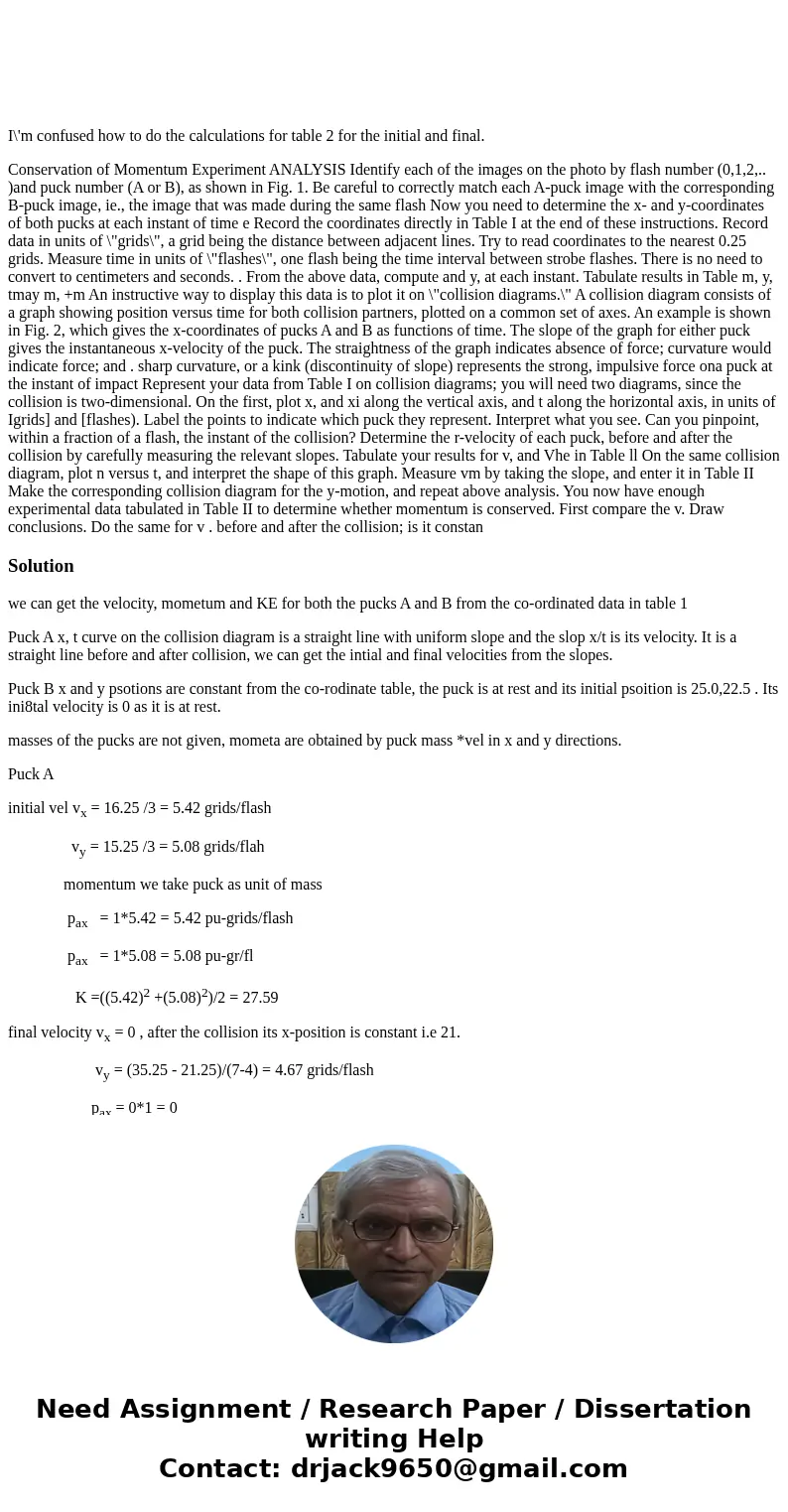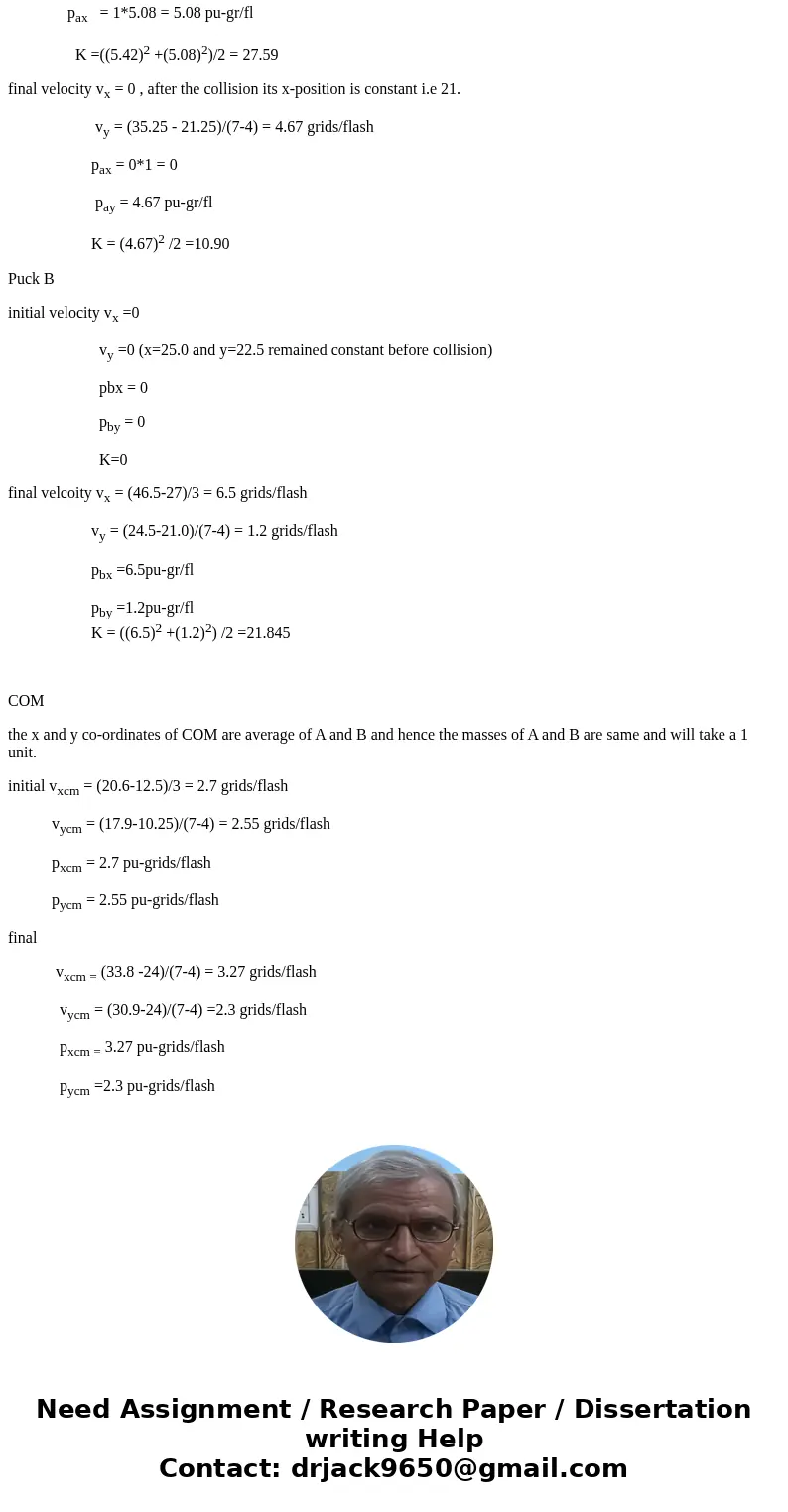I\'m confused how to do the calculations for table 2 for the initial and final.
Conservation of Momentum Experiment ANALYSIS Identify each of the images on the photo by flash number (0,1,2,.. )and puck number (A or B), as shown in Fig. 1. Be careful to correctly match each A-puck image with the corresponding B-puck image, ie., the image that was made during the same flash Now you need to determine the x- and y-coordinates of both pucks at each instant of time e Record the coordinates directly in Table I at the end of these instructions. Record data in units of \"grids\", a grid being the distance between adjacent lines. Try to read coordinates to the nearest 0.25 grids. Measure time in units of \"flashes\", one flash being the time interval between strobe flashes. There is no need to convert to centimeters and seconds. . From the above data, compute and y, at each instant. Tabulate results in Table m, y, tmay m, +m An instructive way to display this data is to plot it on \"collision diagrams.\" A collision diagram consists of a graph showing position versus time for both collision partners, plotted on a common set of axes. An example is shown in Fig. 2, which gives the x-coordinates of pucks A and B as functions of time. The slope of the graph for either puck gives the instantaneous x-velocity of the puck. The straightness of the graph indicates absence of force; curvature would indicate force; and . sharp curvature, or a kink (discontinuity of slope) represents the strong, impulsive force ona puck at the instant of impact Represent your data from Table I on collision diagrams; you will need two diagrams, since the collision is two-dimensional. On the first, plot x, and xi along the vertical axis, and t along the horizontal axis, in units of Igrids] and [flashes). Label the points to indicate which puck they represent. Interpret what you see. Can you pinpoint, within a fraction of a flash, the instant of the collision? Determine the r-velocity of each puck, before and after the collision by carefully measuring the relevant slopes. Tabulate your results for v, and Vhe in Table ll On the same collision diagram, plot n versus t, and interpret the shape of this graph. Measure vm by taking the slope, and enter it in Table II Make the corresponding collision diagram for the y-motion, and repeat above analysis. You now have enough experimental data tabulated in Table II to determine whether momentum is conserved. First compare the v. Draw conclusions. Do the same for v . before and after the collision; is it constan
we can get the velocity, mometum and KE for both the pucks A and B from the co-ordinated data in table 1
Puck A x, t curve on the collision diagram is a straight line with uniform slope and the slop x/t is its velocity. It is a straight line before and after collision, we can get the intial and final velocities from the slopes.
Puck B x and y psotions are constant from the co-rodinate table, the puck is at rest and its initial psoition is 25.0,22.5 . Its ini8tal velocity is 0 as it is at rest.
masses of the pucks are not given, mometa are obtained by puck mass *vel in x and y directions.
Puck A
initial vel vx = 16.25 /3 = 5.42 grids/flash
vy = 15.25 /3 = 5.08 grids/flah
momentum we take puck as unit of mass
pax = 1*5.42 = 5.42 pu-grids/flash
pax = 1*5.08 = 5.08 pu-gr/fl
K =((5.42)2 +(5.08)2)/2 = 27.59
final velocity vx = 0 , after the collision its x-position is constant i.e 21.
vy = (35.25 - 21.25)/(7-4) = 4.67 grids/flash
pax = 0*1 = 0
pay = 4.67 pu-gr/fl
K = (4.67)2 /2 =10.90
Puck B
initial velocity vx =0
vy =0 (x=25.0 and y=22.5 remained constant before collision)
pbx = 0
pby = 0
K=0
final velcoity vx = (46.5-27)/3 = 6.5 grids/flash
vy = (24.5-21.0)/(7-4) = 1.2 grids/flash
pbx =6.5pu-gr/fl
pby =1.2pu-gr/fl
K = ((6.5)2 +(1.2)2) /2 =21.845
COM
the x and y co-ordinates of COM are average of A and B and hence the masses of A and B are same and will take a 1 unit.
initial vxcm = (20.6-12.5)/3 = 2.7 grids/flash
vycm = (17.9-10.25)/(7-4) = 2.55 grids/flash
pxcm = 2.7 pu-grids/flash
pycm = 2.55 pu-grids/flash
final
vxcm = (33.8 -24)/(7-4) = 3.27 grids/flash
vycm = (30.9-24)/(7-4) =2.3 grids/flash
pxcm = 3.27 pu-grids/flash
pycm =2.3 pu-grids/flash


 Homework Sourse
Homework Sourse